Hudson River Almanac 9/28/18 - 10/05/18
The New York State Department of Environmental Conservation sent this bulletin on 10/12/2018 02:00 PM EDT |
| DEC Delivers - Information to keep you connected and informed from the NYS Department of Environmental Conservation |
| Share or view as a web page || Update preferences or unsubscribe |
|
Compiled by Tom Lake, Hudson River Estuary Program Consulting NaturalistOverviewIt was not easy to choose a Highlight this week as harbor seals and sea turtles do not come by often. The autumn education of our students on the river was in full vigor and some of them found inspiration in poetry. HighIight of the Week
On September 10, with particularly high tides and a storm system moving through, the nest started to flood. Permission to dig up the nest and incubate surviving eggs was given by the U.S. Fish and Wildlife Service. Of the 116 eggs they found, 110 were still viable. They put the eggs in incubation boxes and stored them in a nearby park facility. There was still no assurance they would hatch. But last week, the eggshells started cracking, hatching one box at a time. Soon after they’re born, baby turtles go into something called a “frenzy,” a hyperactive period that allows them to scoot across the sand, swim through waves and currents, and reach open water. As soon as Patti Rafferty realized that they had hatchlings in frenzy, they brought them out and released them at the same beach where the nest had been. One by one, they squirmed their way to the water and were gone. Ninety-six Kemp’s ridley hatchings had made it safely to the sea. (Photo of Kemp's ridley sea turtle courtesy of Cara Giaimo) [1995: In late August 1995, Buddy Long was trolling for bluefish near Spuyten Duyvil (HRM 14) when he came upon an injured Kemp’s ridley floating on the surface that had suffered a cracked carapace. It had been struck by a boat propeller (see Hudson River Almanac, Volume II:45). Tom Lake] [In Archie Carr’s book, The Windward Road, he speaks of the ephemeral nature of these sea turtles: “Where the Florida Current picks up its supply of [Kemp's] ridleys is not known, for reasons that I shall reveal presently; but there can be little doubt that it is the northward sweep of this current just off the eastern shore that accounts for the occurrence in North Carolina and New York Harbor and Martha's Vineyard. Little as we know about ridleys, we can be sure that they are not born in those places. They are carried there” (1967:15). Tom Lake] Natural History Entries9/28 – Esopus Meadows, HRM 87: Seining with 60 fourth-graders from Mill Road School in Red Hook proved to be both challenging and rewarding. Donned in chest waders, we hauled our 25-foot-long net and found that each time we beached the net we were faced with 75 pounds of decaying water chestnut mixed with neon green duckweed. But the reward was grand. We caught countless young-of-year river herring and striped bass, banded killifish, assorted sunfishes, white perch, golden shiners, tessellated darters, and seven brown bullhead catfish ranging in size from 25-250 millimeters (mm). [Note: one inch = 25.4 millimeters (mm)]
[Harbor seals (Phoca vitulina) are quite curious, especially with canoes and kayaks. Like all seals, harbor seals will “haul out” to rest. To the seals, the kayaks may have been just floating platforms, like docks, piers, and shoreline rip-rap, familiar haul-out spots. Once hauled out, they assume what we call the “reclining banana” posture that observers often mistake for a seal in distress. In addition to harbor seals, the list of seals documented for the Hudson River estuary includes hooded seals (Cystophora cristata), gray seals (Halichoerus grypus), and harp seals (Pagophilus groenlandicus). Tom Lake] 9/29 – Greene County, HEM 112: As I drove up my driveway this afternoon in West Kill, I was surprised by an immature great blue heron sitting on my lawn. It was surprising because there isn't a pond anywhere close, although there is a trout stream across the road and a narrow mill race with a few frogs near where it was hanging out. As I approached, the heron took off and landed in a field a little farther away. Perhaps it had been exploring and stopped to snack on grasshoppers and dragonflies or the many small rodents in the field. 9/29 – Yonkers, HRM 18: Local students arrived today at the Sarah Lawrence College Center for the Urban River at Beczak for our River Explorers seining program. The tide was extremely high so we went seining in our marsh. The students were excited to see our catch of Atlantic silverside, striped bass, white perch, and blue crabs. One of the large blue crabs had just molted and we were able to discuss soft-shelled crabs and how they grow by discarding their old shell for a new one.
[DEC estimates that there are about 400 moose in the Adirondack Mountains. This is their breeding season, and that may account for this moose’s behavior. Moose are one of our iconic images, along with loons, bald eagles, ravens, black bears, river otters, coyotes, and bobcat, that authenticate the lingering wildness of the Adirondacks. Tom Lake] 10/1 – Esopus Meadows, HRM 87: Second-graders from Duzine Elementary in New Paltz visited us today at Esopus Meadows for our Tideline Program. In four hauls of our seine, we caught many fish and crustaceans. Among the fishes were assorted sunfishes, banded killifish, young-of-year striped bass and river herring, and a four-spined stickleback (Apeltes quadracus). The crustaceans were young-of-summer blue crabs (25 mm). The students helped identify the fish, and we played the “same and different” game, where we note what is the same and what is different between the fishes and us. [The Hudson River Sloop Clearwater's Tideline Program is a field trip to the shores of the Hudson. We go to many parks in the estuary, but Esopus Meadows is our base camp. It is a perfect spot for many reasons: The seining there is great at any tide level, the bottom is not too sticky, and the "Meadows" refers to the shallow flat area of the river. Eli Schloss] 10/1 – New Paltz, HRM 78: Monarch butterflies were seemingly everywhere today at Apple Green’s golf course including the one that rested on my ball on 16th hole. They appeared to be following the ridge over the Shawangunks to get here.
10/1 – Yonkers, HRM18: Fifth-grade students from the Chapel School in Bronxville came to the Sarah Lawrence College Center for the Urban River at Beczak today to go seining. On a gorgeous day we had an exciting catch of Atlantic Silversides (134), mummichogs (50), naked gobies (2), and two young-of-year striped bass. Shore shrimp were also plentiful (53) as were blue crabs (35), and a moon jellyfish. 10/1 – Manhattan, HRM 1: We checked our research sampling gear in Hudson River Park at The River Project's sampling station on the lighthouse tender Lilac at Pier 25, and found a variety of fishes in our pots and traps. Among the smaller fishes were five adorable young-of-year oyster toadfish (35-55 mm) and a postage-stamp size skilletfish (10 mm). Adult fishes included three tautog (205-220 mm). Two feisty blue crabs kept us on our toes (175, 325 mm). 10/2 – Town of Wappinger, HRM 67: Today was the last day we found a ruby-throated hummingbird at our feeders. A chunky adult female took a long drink and then was on her way. This was the latest date we had seen them in recent years. 10/2 – Kowawese, HRM 59: Fifth and sixth-graders from Fox Hill School in Orange County joined us on the beach this morning with a desire to explore the river. Fog covered the Hudson Highlands; Storm King Mountain was draped in white. A strong southeast wind was blowing up through the Highlands pushing waist-high rollers up on the beach. A succession of three green lines high on the beach noted the last three high tides. The interval between each line marked the tidal variance, with those nearest the water being the most recent to arrive. The teachers and students had taken me up on my suggestion, and they all came prepared to feel the river, to get in the water with shorts and sandals. The river was a warm 69-degree Fahrenheit (F). Our tool of discovery was a 35-foot-long seine, and, following nearly a dozen hauls, we tallied up our catch of young-of-year fishes: striped bass (61-112 mm), American shad (84-86 mm), alewife (62-64 mm), blueback herring (46-62 mm), and a single Atlantic menhaden (160 mm). Also, in the seine were white perch, tessellated darters, an American eel, and several tiny young-of-summer male blue crabs (18 mm). [Later in the day, the wind increased, the rain came down in sheets (more than an inch of rain), and a tornado warning was issued by the National Weather Service. Later, they confirmed two tornadoes in the lower Hudson Valley, one in Westchester County and the other at Stony Point in Rockland County.] Fifth and Sixth-graders from Fox Hill School recall their day at the river. YOY Young-of-year Born in summer Hoping not to get eaten, A Windy Day at the Hudson River The sky is grey Lines of duckweed Wind blowing hard Waves roaring An eagle dives above our heads 10/2 – Yonkers, HRM 18: Third-grade students from Riverdale Country School in the Bronx visited at the Sarah Lawrence College Center for the Urban River at Beczak for our marsh and seining program. They spent the morning in the marsh doing sediment samples and having a marsh scavenger hunt. After lunch we went seining at high tide and marveled at how the rising tide had changed the marsh. In seven hauls of our net we caught Atlantic Silverside (73), blue crabs (6), mummichogs, shore shrimp, and four young-of-year striped bass.
10/3 – Yonkers, HRM 18: Third-grade students Riverdale Country School in the Bronx visited the Sarah Lawrence College Center for the Urban River at Beczak today for our marsh and seining program. They spent the morning in the Beczak Marsh doing sediment sampling, and in the afternoon, we went seining in both the marsh and the river. Five hauls in the river and three in the marsh resulted in an exciting catch, including Atlantic silverside, blue crab, mummichogs, shore shrimp, and two young-of-year striped bass. The students were so excited and incredibly inquisitive about all the animals, which made it that much more fun! 10/4 – New Hamburg, HRM 67.5: I noticed a small dark object on my driveway on Rabbit Island today. It turned out to be a tiny snapping turtle hatchling, barely 30 mm across its carapace. That seemed late in the season for a hatchling to be emerging. I gathered it into a bowl for transport to the river and released it at our slip with good wishes for a safe and prosperous life. [Emergence from the nest for snapping turtles should have started by end of August and continued through September, but with dry periods, some nests might have been delayed. Recent rain events that softened the soil might have triggered emergence. - Al Breisch] 10/4 – Yonkers, HRM 18: A second group of third-grade students from Riverdale Country School in the Bronx visited the Sarah Lawrence College Center for the Urban River at Beczak today for our marsh and seining program. As their classmates did yesterday, we learned about a tide marsh and then went seining. The tide was low, the prospects were good, and we eagerly made eight hauls of our net. The students were excited by all of the bright and flashy Atlantic silverside (27) as well as young-of-year striped bass, white perch and a tiny mud crab. 10/4 – Manhattan, HRM 1: We returned to check our research sampling gear in Hudson River Park at The River Project's sampling station on the lighthouse tender Lilac at Pier 25 and found two young-of-year oyster toadfish (30, 50 mm) and a handsome little black sea bass (63 mm). 10/5 – Saratoga County, HRM 182: I drove along Loughberry Lake this afternoon and was pleased to see that a lot of ring-necked ducks (65) had returned for their stay at the lake, a stay that usually lasts until it freezes over in December or January.
[Goldfish (Carassius auratus), are native to east Asia. While they were widely introduced into North America in the early nineteenth century, their presence in the watershed is most often attributed to aquaria release. Domesticated and bred for color, often hybridizing with koi (carp), Hudson River goldfish range from orange to burnished-gold, often mottled with black. In the wild, goldfish can grow to 14-inches and weigh a couple of pounds. Tom Lake] 10/5 – Beacon, HRM 61: A strong north wind had the river capping over, butting the rising tide. You could sense it was a flight day, when a favorable wind would give south-bound migrating birds and butterflies a boost. We saw several bald eagles, many monarchs, a couple flights of ducks in shifting V’s, and one of cormorants all cruising down river. We were on the leeward side of the Point, and the river was calm. We caught nothing new but could see the value in frequently sampling the same location, giving us the chance to see the fauna evolve in both size and species composition. Today’s catch included young-of-year striped bass (64-70 mm), alewives (67-77 mm), and blueback herring (57-66 mm). The river was 70 degrees F. [Windward and leeward are terms that are often used to provide color and accuracy to the description of a location or condition under which a sighting was made. These are sailing terms used to denote wind exposure: windward being in the face of the wind; leeward meaning sheltered, as in the lee of a point, an island, or a stand of trees. - Tom Lake] 10/5 – Yonkers, HRM 18: Third-grade students from the Fieldston School in the Bronx visited the Sarah Lawrence College Center for the Urban River at Beczak today to help us go seining. Our catch was very diverse, and among the fishes were Atlantic silverside, large white perch, young-of-year striped bass, and a single bay anchovy. Elsewhere in the net, and every bit as exciting, were 35 blue crabs, 39 shore shrimp, and a moon jellyfish.
10/5 – Bronx, New York City: Most of Crotona Park Pond in the South Bronx was carpeted with algae, duckweed, and was littered with bottles, cans, sundry refuse, and more than a few basketballs. But it was also teeming with life. After spotting a few red-eared slider turtles basking on vegetation, I was treated to four juvenile painted turtles – native to the watershed – and to my delight, two young-of-year that were no more than an inch-and-a-half long, basking on a fallen log. The other side of the pond had a variety of oaks. A pin oak had dropped so many acorns that it was difficult to walk on the path. I was surprised by a very loud flock of Quaker parrots that raced by so low that I could see their faces. On my way out of the Park, I passed a truly impressive English elm that had to be well over 100 years old. I wondered how many visitors she had hosted in her time. [Monk parakeets, also known as Quaker parrots (Myiopsitta monachus), are native to Central and South America. They have been in the Hudson Valley for about the last 50 years as an exotic release or as an escapee from captivity. Tom Lake] Autumn 2018 Natural History Programs Hudson River Miles DEC's Smartphone app for iPhone and Android is now available at: New York Fishing, Hunting & Wildlife App. NY Open for Hunting and Fishing InitiativeUnder Governor Cuomo's Adventure NY initiative, DEC is making strategic investments to expand access to healthy, active outdoor recreation, connect more New Yorkers and visitors to nature and the outdoors, protect natural resources, and boost local economies. This initiative will support the completion of more than 75 projects over the next three years, ranging from improvements to youth camps and environmental education centers to new boat launches, duck blinds, and hiking trails. Read more about the Adventure NY initiative. For more information on planning an outdoor adventure in New York State, visit DEC's website at http://www.dec.ny.gov/outdoor. |

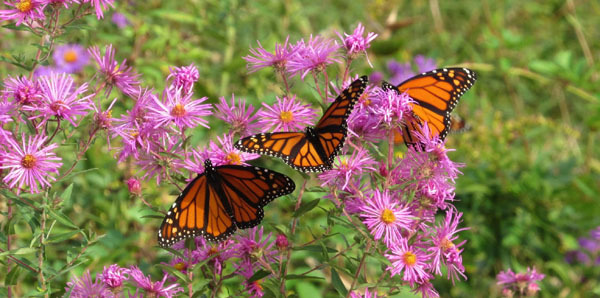 Hudson River Almanac
Hudson River Almanac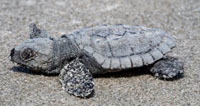 10/3 – Queens, New York City: Last July, beach-walkers at Rockaway Peninsula noticed a Kemp’s ridley sea turtle (Lepidochelys kempii) crawl out of the water and dig herself into the dunes. Kemp’s ridley is the smallest sea turtle in the world and also the rarest. Someone called Maxine Montello, Rescue Program Director for the Riverhead Foundation for Marine Research and Preservation. Maxine Montello noted that this was the first time a Kemp’s ridley was seen actually depositing eggs in New York. The U.S. Fish and Wildlife Service and Patti Rafferty, Chief of Resource Stewardship for the National Park Service’s Gateway National Recreation Area, moved to protect the nest. They built an enclosure to keep out predators and curious people, and Park Rangers came by to check on it every day.
10/3 – Queens, New York City: Last July, beach-walkers at Rockaway Peninsula noticed a Kemp’s ridley sea turtle (Lepidochelys kempii) crawl out of the water and dig herself into the dunes. Kemp’s ridley is the smallest sea turtle in the world and also the rarest. Someone called Maxine Montello, Rescue Program Director for the Riverhead Foundation for Marine Research and Preservation. Maxine Montello noted that this was the first time a Kemp’s ridley was seen actually depositing eggs in New York. The U.S. Fish and Wildlife Service and Patti Rafferty, Chief of Resource Stewardship for the National Park Service’s Gateway National Recreation Area, moved to protect the nest. They built an enclosure to keep out predators and curious people, and Park Rangers came by to check on it every day.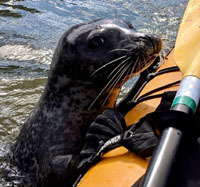 9/28 – Bronx, New York City: Out of the North Brooklyn Boat Club, we were paddling our kayaks up the Harlem River when we noticed a little dark dot in front of us off Inwood in northeast Manhattan. We drifted with the current scanning the surface only to see a harbor seal pop up and look at us with curious eyes. Over the next 15 minutes, it tried to climb onto several of our kayaks making the seal an instant star. We couldn’t help wondering if this animal was in distress or looking for a place to rest. (Photo of harbor seal courtesy of Klaus Rosburg)
9/28 – Bronx, New York City: Out of the North Brooklyn Boat Club, we were paddling our kayaks up the Harlem River when we noticed a little dark dot in front of us off Inwood in northeast Manhattan. We drifted with the current scanning the surface only to see a harbor seal pop up and look at us with curious eyes. Over the next 15 minutes, it tried to climb onto several of our kayaks making the seal an instant star. We couldn’t help wondering if this animal was in distress or looking for a place to rest. (Photo of harbor seal courtesy of Klaus Rosburg) 9/30 – Hamilton County, HRM 242: As I stepped out of my cabin in the woods just after sunrise, I confronted a moose, a female or cow, that looked to be the size of a horse. The moose was in the woods behind my neighbor’s sugar shack (maple syrup) and slowly sauntered out, calling. Undisturbed by my presence, she continued on her way. Moose are not common here, but we see them from time to time. As that drama ended, I heard a loon calling, a tremolo, out on Algonquian Lake. When I found it, the loon dove and I never saw it again. Their ethereal call gives me shivers. (Photo of moose courtesy of Brian Sweig)
9/30 – Hamilton County, HRM 242: As I stepped out of my cabin in the woods just after sunrise, I confronted a moose, a female or cow, that looked to be the size of a horse. The moose was in the woods behind my neighbor’s sugar shack (maple syrup) and slowly sauntered out, calling. Undisturbed by my presence, she continued on her way. Moose are not common here, but we see them from time to time. As that drama ended, I heard a loon calling, a tremolo, out on Algonquian Lake. When I found it, the loon dove and I never saw it again. Their ethereal call gives me shivers. (Photo of moose courtesy of Brian Sweig)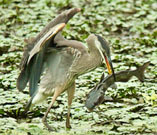 10/1 – Town of Poughkeepsie, HRM 67.5: I watched a great blue heron struggle with a channel catfish in a riverside marsh at Bowdoin Park. After ten-minutes, the heron appeared to come to the realization that this fish was a bit too much to swallow and let it go. (Photo of great blue heron courtesy of Dana Layton)
10/1 – Town of Poughkeepsie, HRM 67.5: I watched a great blue heron struggle with a channel catfish in a riverside marsh at Bowdoin Park. After ten-minutes, the heron appeared to come to the realization that this fish was a bit too much to swallow and let it go. (Photo of great blue heron courtesy of Dana Layton) 10/3 – Norrie Point, HRM 85: We made one perfect set of our 35-foot seine on the river-side of Norrie Point, and the result was a bio-diversity bonanza! The residence fishes included spottail shiner, golden shiner, white perch, tessellated darter, banded killifish, pumpkinseed sunfish, and seaward-heading young-of-year river herring. There were a few surprises in the net as well, including a brilliantly-scaled goldfish, a white catfish (a species that has become almost rare with the advent of the invasive channel catfish), and the prize of the day, a chain pickerel. The river was 66 degrees F. (Photo of chain pickerel courtesy of Melissa Rex)
10/3 – Norrie Point, HRM 85: We made one perfect set of our 35-foot seine on the river-side of Norrie Point, and the result was a bio-diversity bonanza! The residence fishes included spottail shiner, golden shiner, white perch, tessellated darter, banded killifish, pumpkinseed sunfish, and seaward-heading young-of-year river herring. There were a few surprises in the net as well, including a brilliantly-scaled goldfish, a white catfish (a species that has become almost rare with the advent of the invasive channel catfish), and the prize of the day, a chain pickerel. The river was 66 degrees F. (Photo of chain pickerel courtesy of Melissa Rex) 10/5 – Beacon, HRM 61: While I was fishing at Long Dock Park today, a trail-walker alerted me to two adult bald eagles circling up high out over the River. The strong north wind gave them a boost as they disappeared down river past Denning’s Point. From the river, I caught one large carp (13 pounds,10 ounces) and more than a dozen channel catfish, the largest of which was 6 pounds, 7 ounces. The most interesting catch was a brassy-colored goldfish, about nine inches long. (Photo of goldfish courtesy of Ashawna Abbott)
10/5 – Beacon, HRM 61: While I was fishing at Long Dock Park today, a trail-walker alerted me to two adult bald eagles circling up high out over the River. The strong north wind gave them a boost as they disappeared down river past Denning’s Point. From the river, I caught one large carp (13 pounds,10 ounces) and more than a dozen channel catfish, the largest of which was 6 pounds, 7 ounces. The most interesting catch was a brassy-colored goldfish, about nine inches long. (Photo of goldfish courtesy of Ashawna Abbott)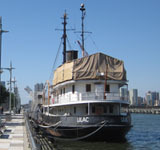 10/5 – Manhattan, HRM 1: We checked our research sampling gear once more this week in Hudson River Park at The River Project's sampling station on the lighthouse tender Lilac at Pier 25, and found two adult fishes, a tautog (280 mm) and an oyster toadfish (220 mm). Being the season of young-of-year fishes, we also caught two oyster toadfish (45 mm). (Photo of Lilac courtesy of Nancy Beard)
10/5 – Manhattan, HRM 1: We checked our research sampling gear once more this week in Hudson River Park at The River Project's sampling station on the lighthouse tender Lilac at Pier 25, and found two adult fishes, a tautog (280 mm) and an oyster toadfish (220 mm). Being the season of young-of-year fishes, we also caught two oyster toadfish (45 mm). (Photo of Lilac courtesy of Nancy Beard)